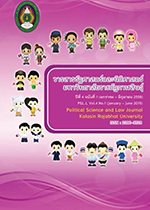ความสัมพันธ์ทางการเมืองระหว่างผู้แทนในระดับต่างๆ กับเครือข่ายเสื้อแดงในพื้นที่ระดับหมู่บ้าน : กรณีศึกษาหมู่บ้านโพนนาดี - โพนวิสัย อำเภอเขาวง จังหวัดกาฬสินธุ์
DOI:
https://doi.org/10.14456/gjl.2015.9คำสำคัญ:
เครือข่ายคนเสื้อแดง, ผู้แทน, ความสัมพันธ์ทางการเมือง, the Red -Shirts network, representative, political relationshipบทคัดย่อ
การศึกษาครั้งนี้มีวัตถุประสงค์เพื่อศึกษารูปแบบ ลักษณะความสัมพันธ์ ทางการเมืองในพื้นที่ เงื่อนไขหรือปัจจัยที่นำไปสู่ความสัมพันธ์ทางการเมืองในพื้นที่ และผลของความสัมพันธ์ระหว่างผู้แทนตั้งแต่ระดับกำนัน - ผู้ใหญ่บ้าน ผู้บริหารและ สมาชิกสภาท้องถิ่น และสมาชิกสภาผู้แทนราษฎร กับเครือข่ายคนเสื้อแดงในพื้นที่ ระดับหมู่บ้าน ประชากรเป้าหมาย ได้แก่ กำนัน - ผู้ใหญ่บ้าน, ผู้บริหารและสมาชิก สภาท้องถิ่น และสมาชิกสภาผู้แทนราษฎรหรือตัวแทนของสมาชิกสภาผู้แทนราษฎรที่ ดูแลพื้นที่ ประธานกลุ่มเครือข่ายต่างๆ ในหมู่บ้าน ผู้อาวุโสหรือแกนนำชาวบ้านที่เป็น ที่นับถือของคนในหมู่บ้าน ชาวบ้านที่เคยเข้าร่วมกิจกรรมทางการเมืองในระดับต่างๆ จำนวนทั้งสิ้น 18 คน พื้นที่ศึกษา ได้แก่ หมู่บ้านโพนนาดี โพนวิสัย หมู่ที่ 3, 4, 6 และ 10 ตำบลหนองผือ อำเภอเขาวง จังหวัดกาฬสินธุ์ ใช้วิธีการสัมภาษณ์เชิงลึกและ การสัมมนากลุ่มย่อยระหว่างกลุ่มตัวอย่างด้วยกัน เป็นเครื่องมือในการเก็บรวบรวมข้อมูล วิเคราะห์ข้อมูลด้วยการวิเคราะห์ความสอดคล้องระหว่างเนื้อหา เชื่อมโยงแนวคิดและ ทฤษฎีที่เกี่ยวข้อง ผลการศึกษาพบว่า รูปแบบและลักษณะความสัมพันธ์ทางการเมือง ระหว่างผู้แทนในระดับต่างๆกับเครือข่ายคนเสื้อแดงในระดับหมู่บ้าน มีหลายรูปแบบ ซึ่งนำไปสู่การเกิดเครือข่ายคนเสื้อแดงในหมู่บ้านเพื่อขับเคลื่อนแนวคิดการพัฒนาชีวิต ความเป็นอยู่ของชาวบ้านด้วยกันเองให้ไปสู่ความกินดีอยู่ดีและมีคุณภาพชีวิตที่ดีได้ โดยไม่ผ่านผู้แทนในระดับต่างๆ ที่เป็นตัวแทนในหมู่บ้าน หรือให้ผู้แทนเป็นเพียงฝ่าย สนับสนุนแนวคิดดังกล่าวของเครือข่ายชาวบ้าน หรืออำนวยความสะดวกให้ชาวบ้าน ทำงานตามแนวคิดตนไปสู่ความสำเร็จตามที่ปรารถนาThis study has the objectives to study the pattern, the characteristic of the political relationship in arena , the condition and factors toward the political relationship in arena , and the result of the relationship among the representatives in the each level of Sub-district headman-Village headman, executive and members of the local parliament, and the parliament representatives and the Red -Shirts network in the village level. The target samples are the Sub-district headmans-Village headmans, the executives and local parliament members, and the parliament representatives or agents taking care in the areas, the presidents of the networks in the villages, the seniors or the citizen core who is respectable from the villagers, the villages who enrolled in the political activities in various level, the total number is 18 peoples. The study area is the Phonnadi - Phonvisai village, at Moo 3, 4, 6, and 10, Nongpue sub-district, Kaowong district, Kalasin province. The in-depth interview and the focus group among the sample are used to be the method of the collecting data and analyze the data by the consistency analysis among the contents, connecting the related concepts and theory. The results shows that the pattern and the characteristics of the political relationship among the representatives in each level and the Red -Shirts networks in the village level have several patterns. These factors and conditions brought to have the citizen network in the village to drive the concept of the way of life development of the villagers to be more well being and better life quality by not passing the representative or allowing the representatives have only the supporting role to support the concept of the Red -Shirts network or facilitate the villagers working following their ideas to succeed as they need.
Downloads
ดาวน์โหลด
เผยแพร่แล้ว
รูปแบบการอ้างอิง
ฉบับ
ประเภทบทความ
สัญญาอนุญาต
ลิขสิทธิ์ (c) 2017 วารสารการบริหารปกครอง (Governance Journal)

อนุญาตภายใต้เงื่อนไข Creative Commons Attribution-NonCommercial-NoDerivatives 4.0 International License.








